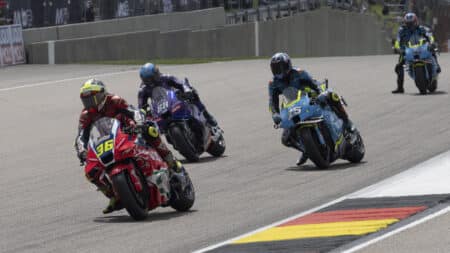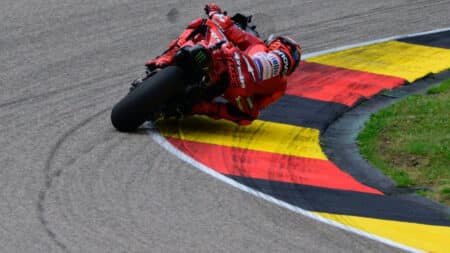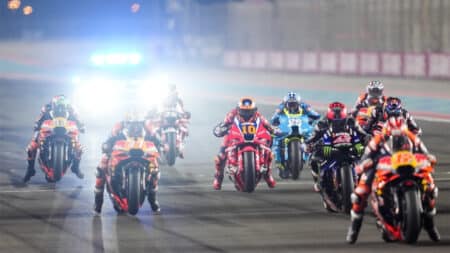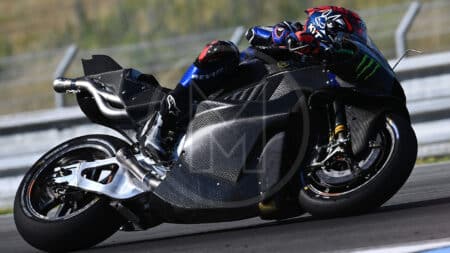Back in the heady days of Marlboro Team Roberts domination, King Kenny Roberts had a favourite saying, which he would shout at full volume during the team’s frequent and legendarily messy victory dinners. Full of wine, joy and relief, King Kenny’s voice would boom around the dining room: “Who got fourth?” In other words, who cares who got fourth when his crew had won the race?

Well, everyone at Brno knew who got fourth. During the top three press conference – Dani Pedrosa, Jorge Lorenzo and Valentino Rossi – one journalist was polite enough to apologise for asking so many questions about Marc Márquez who, for the first time in his short but uniquely wonderful MotoGP career, had ridden past the chequered flag and straight back into his pit, with no reason to stop in the parc fermé.
Journalists who had been ready to write him into the history books had to find something else to write about. But let’s pretend for a moment that he did win his 11th consecutive race, a feat only matched or bettered by three riders from the 1960s: John Surtees won 11 successive GPs during 1958, 1959 and 1960, Mike Hailwood won 12 on the trot in 1963 and 1964 and Giacomo Agostini went unbeaten at 20 races during 1968 and 1969; all of them riding mighty MV Agusta multis.

Mike Hailwood. Photo: MV Agusta
I have as much respect for racing history as anyone, but if Márquez had won his 11th successive race on Sunday, that statistic would have been a cornerstone in arguments suggesting that he’s the greatest of all time.
I would never dare belittle the achievements of those three 1960s icons who raced round lethal street circuits every weekend on rattling, wobbling motorcycles. But from a competition point of view – from racing rivals rather than missing scenery – their achievements pale into insignificance against those of Márquez. The history books tell you that those MV riders usually had no serious rivals, mostly a motley crew of impoverished privateers struggling around on single-cylinder machines from Norton and Matchless; rather like Márquez beating Mike Di Meglio into second place on his ZX-10R-powered Avintia.
New rules
While we were at Brno on Sunday evening and coming to terms with the fact that Márquez had inconveniently prevented us from rewriting the history books, a press release arrived from the Grand Prix Commission, MotoGP’s governing body composed of Dorna CEO Carmelo Ezpeleta, the FIM’s Ignacio Verneda, IRTA president Hervé Poncharal and MSMA rep Takanao Tsubouchi.

Carmelo Ezpeleta
While we weren’t rewriting the history books, the GPC had been busy rewriting the rule book. Their rewrite of the Sporting Regulations read thus: “Effective 2015: age limits in the Moto3 class. The winner of the FIM CEV Moto3 Championship is permitted to compete in the Moto3 class of MotoGP in the following season, even if the rider has not reached the minimum age for the class. (Currently 16 years).”
The minimum age limit – briefly reduced to 15 some years ago – is 16 for a good reason. You aren’t allowed to join the army at 15, so why should you be able to race at Grand Prix level? Motorcycle racing is a grown-up’s sport, at least at world level.
So, why have the rules been changed? Because there’s a talented young Frenchman called Fabio Quartararo who’s currently ruling the CEV Moto3 class. In other words the rules have been changed for one person. To make matters worse, Quartararo is managed by Emilio Alzamora – 1999 125 World Champion and mentor of Márquez – and rides for the Junior Estrella Galicia team, sponsored by Spanish oil giant Repsol, HRC and Spanish beer brand Estrella Galicia (who also sponsor Repsol Honda and Honda’s number one Moto3 squad).

In other words, this is another act by MotoGP’s old boys, who recently refused to change the rules to let struggling Open MotoGP riders get an extra tyre for QP2 tyre because they say it’s not right to rewrite the regulations mid-season. But when it suits them – when the more powerful corporate interests want their self-interests to be indulged – then anything goes.
I’m sure Quartararo is a genius rider– hell, he won the 2013 CEV tile at the age of 14 – and I look forward to him riding in Grands Prix, but rules should not be changed to suit one rider, when everyone else has to do what they’re told or get into trouble; like Esteve Rabat who copped a €1000 fine for making us all laugh at the end of Brno’s Moto2 race when he rode his victory lap carrying a passenger dressed in a chequered gimp suit.
This rule rewrite stinks and can’t help but make me take the people in charge even less seriously than I already do. They’re a bunch of power-crazed, self-interested rich kids who treat MotoGP as their playground, but woe betide anyone else who steps out of line.
Circuit of Wales

Click to zoom in
Which brings me to the Circuit of Wales. The more I know and the more I think about the venture, it doesn’t add up. The world is littered with racetracks that were going to regenerate struggling areas. There’s Rockingham and then there’s Phakisa Raceway in Welkom, South Africa, constructed to bring much-needed jobs to a former mining community fallen on hard times. (A bit like COW, really). So did Phakisa revitalise Welkom? Did it hell. After several years of government money the promoter fled to the USA with several million in his back pocket.
The Circuit of Wales is a lovely idea, and if it’s a success I’ll be delighted for all concerned. But I have major doubts that it’s a viable year-round project. Circuits do not employ many people. Jonathan Palmer’s MSV business – Brands Hatch, Snetterton, Oulton and Cadwell – employs about 200 full time staff. COW talks about the circuit and neighbouring business park employing 6000. If only. No, if you want to create meaningful jobs, build a factory that makes stuff and will employ hundreds of full-time employees for decades to come.
I can’t help but see the whole venture as some cynical ploy that Dorna can use to play games with Silverstone and Donington, rather as Bernie Ecclestone used to play games with the BRDC and Silverstone.

Donington, 2009
Dorna are already laughing, having taken the MotoGP TV rights away from the BBC and flogged them at a premium price to BT Sport, which must be wondering what it’s bought. MotoGP used to regularly attract around 1.1 million viewers on the BBC. BT gets less than 200,000. This isn’t a concern for Dorna. Britain has lost its bike racing shop window but the BT fee has fattened Dorna’s balance sheet to raise the company’s apparent value for the day when private-equity owners Bridgepoint sell the company and have a nice time in the Maldives with the profits.











